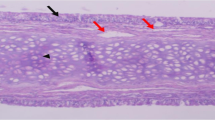Summary
The aim of the study was to characterize the nature of the formaldehyde-induced nasal response consisting in symptoms of rhinitis and changes in nasal lavage fluid. Eleven healthy subjects and nine patients with specific skin sensitization were provoked in a toxicological chamber with formaldehyde at a dose of 0.5 mg/m3 over 2 h. Nasal lavage was performed prior to and immediately after provocation and 4 and 18 h later. Provocation with formaldehyde caused transient symptoms of rhinitis and prolonged changes in nasal washings. There were increases in the number and proportion of eosinophils and elevated albumin and total protein levels in nasal lavage fluid 4 and 18 h after provocation. No difference in the nasal response to formaldehyde was found between patients with skin sensitization and healthy subjects. These data confirm the irritative effects of formaldehyde and are also suggestive of nonspecific proinflammatory properties when formaldehyde is inhaled at a low (0.5 mg/m3) dose.
Similar content being viewed by others
References
Bardana JB, Montanaro A (1991) Formaldehyde: an analysis of its respiratory, cutaneous and immunologic effects. Ann Allergy 66:441–446
Barnes PJ (1987) Neuropeptides in human airways: function and clinical implications. Am Rev Respir Dis 136:S16-S26
Bascom R, Pipkorn U, Lichtenstein LM, Naclerio RM (1988) The influx of inflammatory cells into nasal washings during the late response to antigen challenge; effect of systemic corticosteroids. Am Rev Respir Dis 138:406–412
Brofeldt S, Mygind N, Sorensen CH, Marriot C (1986) Biochemical analysis of nasal secretions induced by methacholine, histamine and allergen provocations. Am Rev Respir Dis 133:1138–1142
Castells M, Schwartz LB (1988) Tryptase levels in nasal-lavage fluid as an indicator of the immediate allergic response. J Allergy Clin Immunol 82:348–355
Chang JCF, Gross EA, Swenberg JA, et al. (1983) Nasal cavity deposition, histopathology and cell proliferation after single or repeated formaldehyde exposures in B6C3F mice and F344 rats. Toxicol Appl Pharmacol 68:161–171
Drury RA (1967) Carleton's histological technique. Oxford University Press, New York p 309
Edling C, Herlquist H, Odkvist L (1988) Occupational exposure to formaldehyde and histopathological changes in the nasal mucosa. Br J Ind Med 45:761–765
Grammer LC, Harris KE, Shaughnessy MA, et al. (1990) Clinical and immunologic evaluation of 37 workers exposed to gaseous formaldehyde. J Allergy Clin Immunol 86:177–181
Greiff L, Pipkorn U, Alkner U, Persson CGA (1990) The “nasal pool” device applies controlled concentrations of solutes on human nasal airway mucosa and samples its surface exudation/secretions. Clin Exp Allergy 86:599–605
Hansel FK (1954) The cytology of secretions in allergy. In: Hansel FK (ed) Clinical allergy. CV Mosby, St. Louis, pp 408–419
Hewndrick DJ, Rando RJ, Lane DJ, et al. (1982) Formaldehyde asthma challenge exposure levels and late reactions after 5 years. J Occup Med 24:897
Kalendarian R, Raju L, Roth W, Schwartz LB (1988) Elevated histamine and tryptase levels in smoker's bronchoalveolar lavage fluid. Do lung mast cells contribute to smoker's emphysema? Chest 94:119–123
Lowry OL, Rosebrough MJ, Farr AL, Randall RJ (1951) Protein measurement with the folin-phenol reagent. J Biol Chem 193:265–275
Maibach HI (1983) Formaldehyde: effects on animal and human skin. In: Gibson JE (ed) (1983) Formaldehyde toxicity. Hemisphere, pp 163–174
Mattson DE (1981) Statistics. C.V. Mosby, St. Louis.
Raphael GD, Meredith SDF, Baraniuk JN, Druce HM, Banks SM, Kaliner MA (1989) Pathophysiology of rhinitis. II. Assessment of the sources of protein in histamine-induced nasal secretions. Am Rev Respir Dis 139:791–800
Raphael GD, Igarashi Y White MV, Kaliner MA (1991) The pathophysiology of rhinitis. Sources of protein in allergen induced nasal secretions. J Allergy Clin Immunol 88:33–42
Walker KB, Serwonska MJ, Valvone FJ et al. (1988) Distinctive patterns of release of neuroendocrine peptides after nasal challenge of allergic subjects with ryegrass antigen. J Clin Immunol 8:108–113
Zeiger RS, Yurdin DL, Colten HR (1976) Histamine metabolism, II. Cellular and subcellular of localization in the catabolic enzymes, histaminase and histamine methyl transferase in human leukocytes. J Allergy Clin Immunol 58:172–179
Author information
Authors and Affiliations
Rights and permissions
About this article
Cite this article
Pazdrak, K., Górski, P., Krakowiak, A. et al. Changes in nasal lavage fluid due to formaldehyde inhalation. Int. Arch Occup Environ Heath 64, 515–519 (1993). https://doi.org/10.1007/BF00381101
Received:
Accepted:
Issue Date:
DOI: https://doi.org/10.1007/BF00381101




